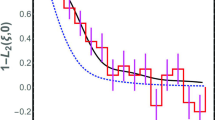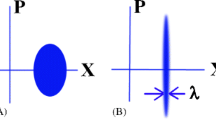Abstract
The details of Fröhlich's theory and some recent experiments on the rouleau formation of human erythrocytes which exhibit a strong interaction that appears to satisfy the prerequisites of the Fröhlich theory, are summarized. To verify whether the Fröhlich theory of long-range coherence in biological systems is applicable to the phenomenon of rouleau formation in human erythrocytes, the interactions between erythrocytes are modelled as those between two large, coupled oscillating dipoles. Relevant expressions for the resonant long-range and the van der Waals interaction are then derived. Using the available numerical data, the eigenfrequencies and the interaction energies corresponding to the experimental conditions are then derived. In the range of postulated frequencies (1011–1012 Hz) the effective interaction coefficient Ξ due to the resonant long-range forces is, indeed, found to agree with its experimental value of 3.0. However, the same value of Ξ can also be achieved through the ordinary van der Waals interactions between dipoles oscillating at lower frequencies. It is concluded that the resonant long-range interaction between erythrocytes may be responsible for the onset of rouleau formation. However, other mechanisms cannot be ruled out at this stage, especially since the Fröhlich mechanism requires a number of unconfirmed preconditions.
Similar content being viewed by others
References
BlinowskaK. J., LechW., and WittlinA. (1985) Phys. Lett. A 109, 124.
BrooksD. E. (1973) J. Coll. Interface Sci. 43, 687; 707; 714.
BrooksD. E. and SeamanG. V. F. (1973) J. Coll. Interface Sci. 43, 670.
ChanceB., MuellerP., DeVaultD., and PowerL. (1980) Physics Today 80, 32.
DavydovA. S. (1985) Solitons in Molecular Systems, D. Reidel, Dordrecht.
DelGiudiceE., DogliaS., MilaniM., and VitielloG. (1985), Nucl. Phys. B 251, 375.
DeRobertisE. D. P. and DeRobertisE. M. F.Jr. (1980) Cell and Molecular Biology, Holt, Rinehart and Winston. New York.
EvansE. (1986) Biorheology 23, 192.
FritzO. G. (1984) Biophys. J. 46, 219.
FröhlichH. (1958) Theory of Dielectrics, Oxford University Press, London.
FröhlichH. (1972) Phys. Lett. A 39, 153.
FröhlichH. (1978) IEEE Trans., MIT 26, 613.
FröhlichH. (1980) Adv. Electron. Electron. Phys. 53, 85.
Gingell, D. and Parsegian, V. A. (1971) Biophys. Soc. Abstracts, 15th Annual Meeting.
GrantE. H., SheppardR. J., and SouthG. P. (1978) Dielectric Behavior of Biological Molecules in Solution, Oxford University Press, Oxford.
HastedJ. B. (1973) Aqueous Dielectrics, Chapman and Hall, London.
LutzH. U., LiuS. C., and PalekJ. (1977) J. Cell. Biol. 73, 548.
Müller-HeroldU., LutzH. U., and KedemO. (1987) J. Theor. Biol. 126, 251.
NakaoM., NakaoT., and YamazoeS. (1960) Nature 187, 945.
PaulR., ChatterjeeR., TuszyńskiJ. A., and FritzO. G. (1983) J. Theor. Biol. 104, 169.
PokornyJ. (1980) Czech. J. Phys. B 30, 1339.
PonderE. (1957) Révue d'Hématologie 12, 11.
ReichR. R. (1978) Hematology: Physiopathologic Basis for Clinical Practice, Little, Brown, New York.
RossS. W. and EbertR. V. (1959) J. Clin. Invest. 38, 155.
RowlandsS., SewchandL. S., LovlinR. E., BeckJ. S., and EnnsE. G. (1981) Phys. Lett. A 82, 436.
RowlandsS., SewchandL. S., and EnnsE. G. (1982) Phys. Lett. A 87, 256; Can. J. Physiol. Pharm. 60, 52 (1982).
RowlandsS., EisenbergC. P., and SewchandL. S. (1983) J. Biol. Phys. 11, 1.
SewchandL. S. and RowlandsS. (1983) Phys. Lett. A 93, 363.
SiehJ. B. and SterlingC. (1969) Biochim. Biophys. Acta 184, 281.
SteckT. L. (1974) J. Cell. Biol. 62, 1.
TuszyńskiJ. A. (1985) Phys. Lett. A 107, 228.
WebbS. J. (1980) Phys. Rep. 4, 201.
WeedR. I., LaCelleP. L., and MerrillE. W. (1969) J. Clin. Invest. 48, 795.
Author information
Authors and Affiliations
Rights and permissions
About this article
Cite this article
Tuszyński, J.A., Strong, E.K. Application of the Fröhlich theory to the modelling of rouleau formation in human erythrocytes. J Biol Phys 17, 19–40 (1989). https://doi.org/10.1007/BF00393324
Accepted:
Issue Date:
DOI: https://doi.org/10.1007/BF00393324




